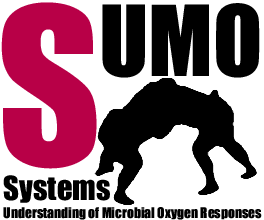WP2.1 Development of agent-based models describing the response of E. coli to changes in oxygen availability
Michael Holcombe, Afsaneh Maleki-Dizaji
A hybrid model that consists of agent-based and conventional mathematical components has been constructed to obtain a systems-level understanding of the synthesis of alternative oxidases in E. coli. In WP1.1 the abundances of the high affinity oxidase CydAB in E. coli cultures grown under conditions of different oxygen availability have been measured. In addition, the relative activity of the FNR protein in vivo was measured using an FNR-dependent promoter fusion. Expression of the cydAB operon is repressed by FNR and activated by ArcA. Using these data, we constructed a mathematical model of cydAB (operon) expression using the Hill equation and Michaelis-Menten kinetics using the COPASI modelling software. At steady state we obtain the following model equations describing the concentration of active ArcA in depending on measured FNR activity and CydAB protein concentrations.
The agent-based model part involves the representation of each individual molecule of interest as an autonomous agent that exists within the cellular environment and interacts with other molecules according to the biochemical situation. The specification of each of these agents is defined in the XMML language. An agent-based chemical model does not have the same restrictions as a differential equation model; any number (low or high, within computational limitations) and distribution of molecules can be modelled, spatial concerns can easily be accounted for, as can time delays, and individual interactions of agents do not produce the same ‘volatility’ as several interdependent differential equations. Molecules each have a location within the cell – some may be close to the membrane, others more uniformly distributed. Molecules can move through 3D space in the cell and interact with each other when close enough and in a suitable state. The FLAME framework (Flexible Large-scale Agent-based Modelling Environment) http://www.flame.ac.uk allows us to define each type of molecule agent in a precise way and we will then convert this information, together with an initial distribution of molecules into a simulation program. This part of the model uses existing datasets and knowledge to develop an E. coli ArcA and Fnr respiratory adaptation model. The agent model consists of the following types of agents: oxygen (O2 molecules), E. coli cell, FNR (molecules), quinone (Q molecules), ArcB (molecules) and ArcA (molecules). Each agent communicates with the others via message passing. These messages include information about where each molecule is and what state it is in. On reading this information, a group or agents that are located within a suitable area can then engage in further activities (e.g. bind together, disassociate). Each molecule is specified in the XMML language and information about its location (abstract co-ordinates), its state, its ability to interact with other molecules and the conditions under which this happens are encoded in its definition. The binding of O2 molecules has been modeled by interpreting the k rate in terms of interaction radius and dealing with the issue of FNR and the terminal oxidases competing to bind to O2. Disassociation was dealt with by applying a probabilistic k rate. Molecules move differently in different regions of the cytoplasm and this was modelled by controlling the movement of agents in the different areas and changing their location by Brownian motion.
